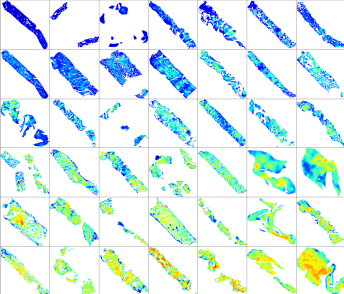AI for faster, safer, and more effective trials
We work with leading biotech and pharma companies to research, develop and deploy deep learning algorithms that improve characterisation of morphologic features from standard tissue slides.
First in ways that help us better keep track of phenomenon we already understand but measure poorly and then to discover new markers of disease.
Our work is validated on samples from the clinical workflow at Oxford University Hospital and independent international datasets across the world.
Clinical trial applications
Biologically meaningful grouping; beyond molecular subtyping

We identify known and novel biologically-relevant subtypes and categorise trial participants into the appropriate groups with a consistency and precision that current pathology workflows cannot match.
Unique, expert-curated reference cohorts enable us to generate reliable patient stratification even from small trial populations.
Insights to power your trial recruitment, protocol design and in-trial management.
Immediate treatment response and disease progression insights

Understand response to therapy against the larger context of our curated, representative cohorts of the disease.
Longitudinal analysis of single patients as well as cohort and subtype response patterns identified and illustrated against a morphologically and biologically relevant feature space.
Quantitative analysis; robust measures of well accepted markers of disease
Systematic, quantitative analysis of samples that accounts for molecular, demographic, and contextual data.
Enable analysis of the entire sample via our heat-mapping of the whole slide to identify areas of interest.
Interpretable and reproducible insights you can trust.
Case study; fibrosign for continuous indexing of fibrosis in an MPN trial of an anti-fibrotic small molecule
We have delivered trial-defining insights to global biopharma companies
1
Stratify patients at screening
Using our AI-biomarkers, we retrospectively identified and subtyped patients for a top 5-biopharma trial cohort. Significantly, if this approach is leveraged during screening, it presents a crucial improvement, especially in scenarios where manual pathology falls short in meeting inclusion/exclusion criteria.

2
Consistent analysis; super-powering your pathology capabilities
Systematic, quantitative analysis of samples that accounts for molecular, demographic, and contextual data.
Enable analysis of the entire sample via our heat-mapping of the whole slide to identify areas of interest.
Interpretable and reproducible insights you can trust.

3
Immediate treatment response and disease progression insights
The benefit of quantitated morphology-based measurements was particularly valuable for assessment of single participant and sub-group response and progression insights.
We detected a pattern of response based on a patient's initial position against our curated cohort.

Boost your histology,
start using tissue biomarkers today
We're applying our technology to trials, research, and clinical audits today.
Get in touch